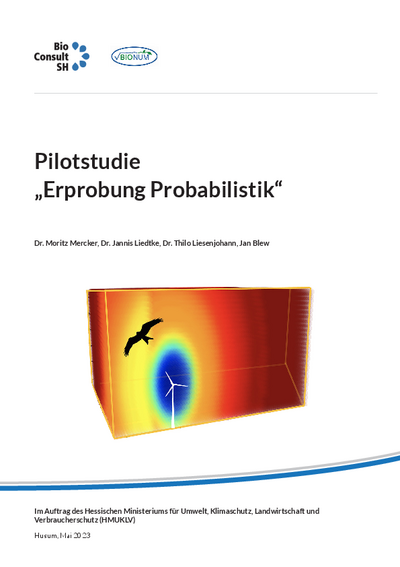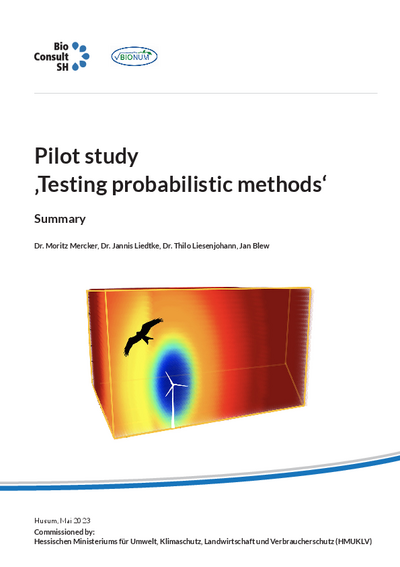The habitat use-collision risk model
A probabilistic approach is seen as a way to re-evaluate the risk of collision or mortality and thus conflicts with species protection in a further development of wind energy use.
How high is the risk that birds collide with wind turbines?
The term “probabilistics” (also called “probability theory”) refers to the process of estimating or predicting probabilities. In order to be able to make these predictions, mathematical models of the underlying process are usually combined with an analysis of collected data.
The mathematical model has to be as close to reality as possible and the empirical data used has to be as reliable as possible. However, the latter are usually associated with random processes that also need to be considered in the right context.
A collision risk model (CRM) is such a probabilistic model that should estimate the risk (i.e. the probability) of a collision under specific conditions (e.g. depending on location, bird species and/or wind turbine) as accurately as possible.
The habitat use-collision risk model (Raumnutzungs-Kollisionsrisikomodell – RKR) is the continuation and completion of the approach formerly known as the hybrid model.
Aim of the project and method
The habitat use-collision risk model was preceded by a pilot study (Mercker et al. 2023).
Aim of this pilot study was to develop and test probabilistic methods to determine the project-related mortality risk of breeding bird species at risk of collision with wind turbines.
To this end, existing modelling approaches and available data were evaluated. The authors developed a new preliminary model (hybrid model), which describes the basic aspects of habitat use and the collision risk per flight through the rotor swept area based on the example of the red kite.
In the follow-up study published in 2024 (Mercker et al. 2024a), the hybrid model developed in the pilot study was further evaluated and refined to improve its practicability.
Several improvements were made, among others in relation to the prediction of habitat use and the avoidance behaviour of red kites near wind turbines. The result of the revisions is a habitat use-collision risk model (Raumnutzungs-Kollisionsrisikomodell – RKR).
So far, the study has focused on the red kite. Plans are in place to test the model for possible application for white-tailed eagles and white storks in 2024.
Papers and reports
Fortsetzungsstudie Probabilistik
Das „Raumnutzungs-Kollisionsrisikomodell“ („RKR-Modell“): Fachliche Ausgestaltung einer probabilistischen Berechnungsmethode zur Ermittlung des Kollisionsrisikos von Vögeln an Windenergieanlagen in Genehmigungsverfahren mit Fokus Rotmilan. Im Auftrag des Bundesamts für Naturschutz.
Further information
Probabilistics - pilot study
BioConsult SH and Bionum carried out the pilot study on probabilistics on behalf of the Hessian Ministry for the Environment, Climate Protection, Agriculture and Consumer Protection.
The pilot study was initiated by sub-working group 2 “Probabilistics” of the Conference of Environment Ministers (UMK) within the framework of the acceleration of the energy transition and the associated approval procedures.
Please refer to the Competence Centre for Nature Conservation and Energy Transition (KNE) for additional information (in German).
On behalf of
Funding period
2022 to 2023
Project partners
Habitat use-collision risk model
The habitat use-collision risk model of the follow-up project was developed on behalf of the Hessisches Ministerium für Landwirtschaft und Umwelt, Weinbau, Forsten, Jagd und Heimat by BioConsult SH, Bionum and TB Raab.
The model, which is currently approved for the red kite, shall be extended to apply to white-tailed eagles and white storks in the short term and further species at risk of collision in the medium term.
Please refer to the Competence Centre for Nature Conservation and Energy Transition (KNE) for further information (in German).
On behalf of
Funding period
2023 to 2024
Project partners


![[Translate to English:] Fortsetzungsstudie Probabilistik](/fileadmin/_processed_/f/e/csm_Fortsetzungsstudie_Probabilistik_Mercker_et_al_2024_57e472ef9d.png)



 bioconsult-sh.de
bioconsult-sh.de